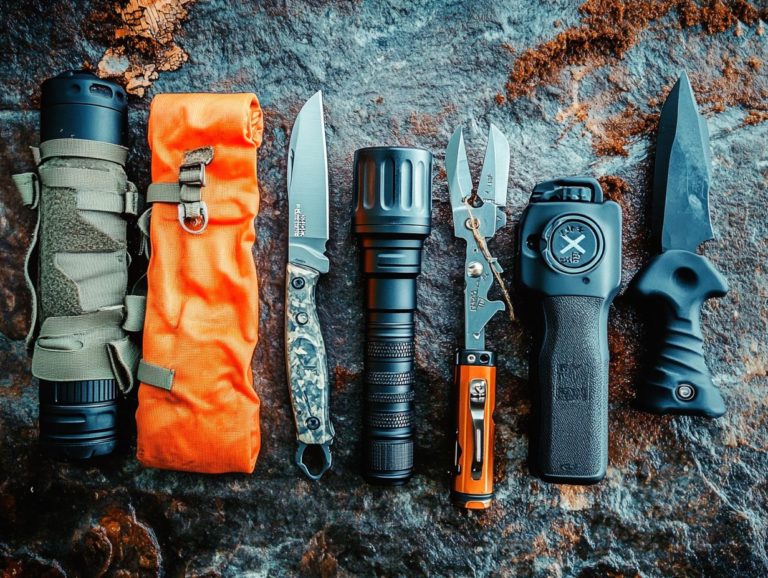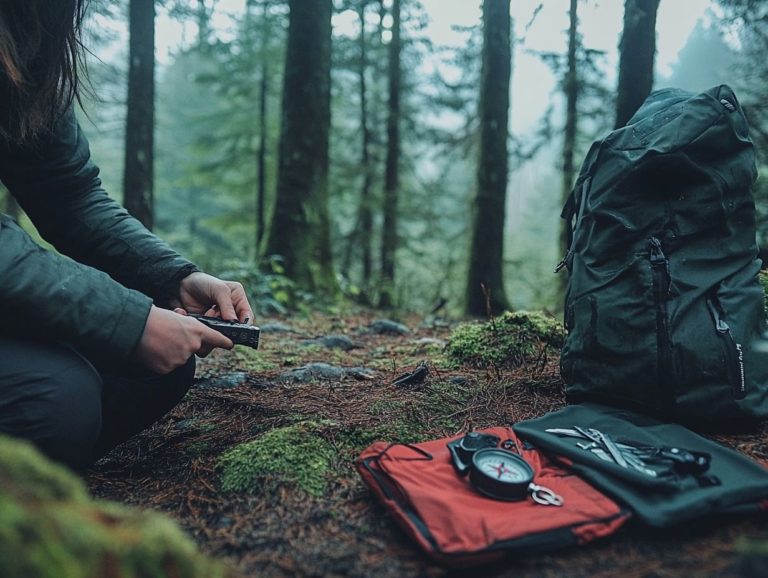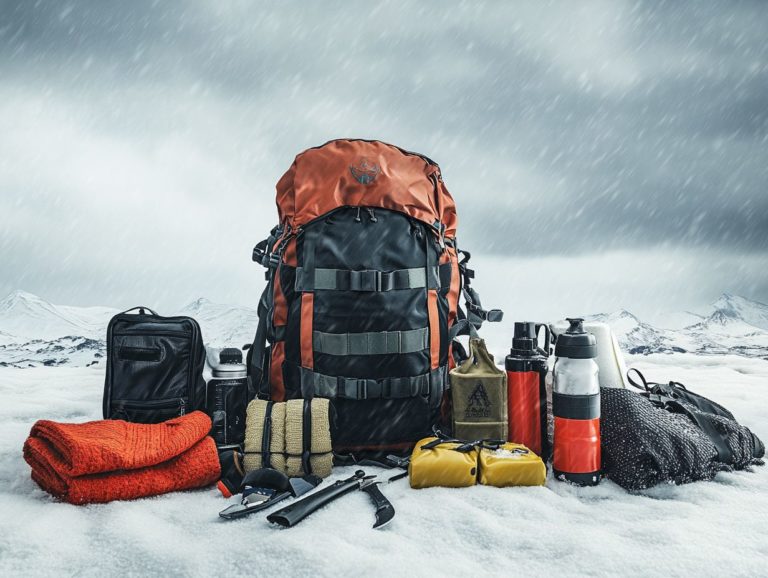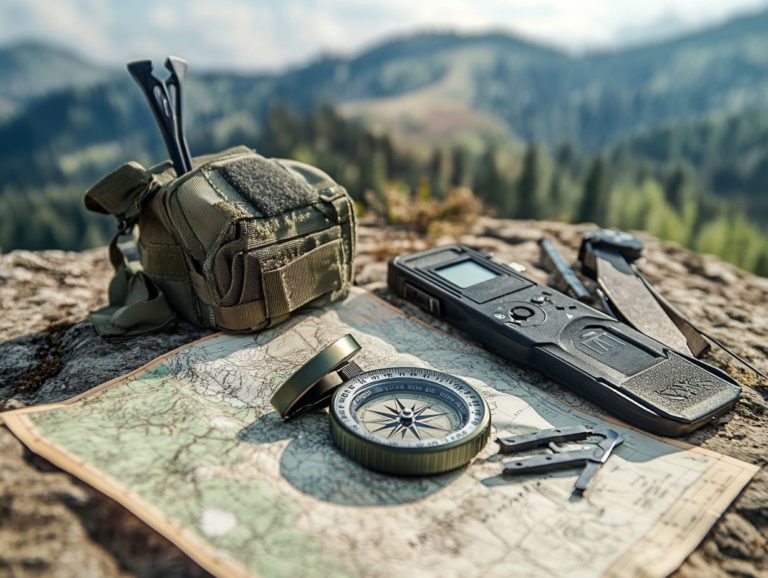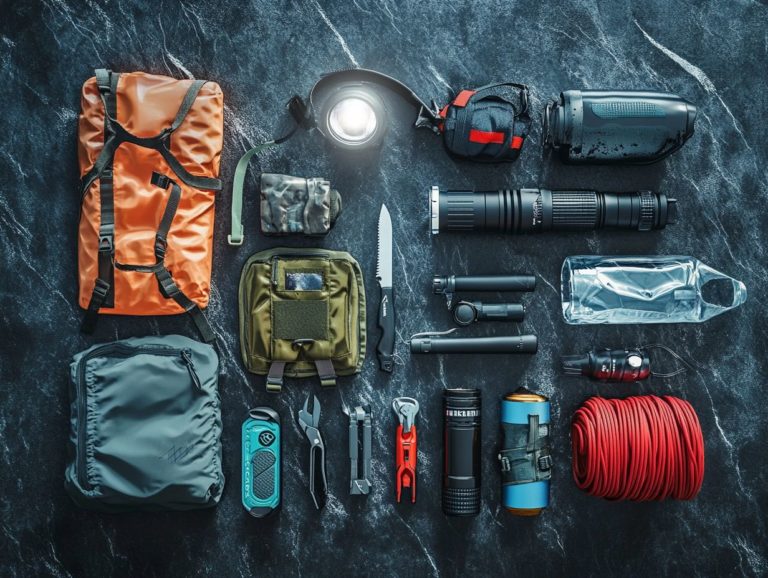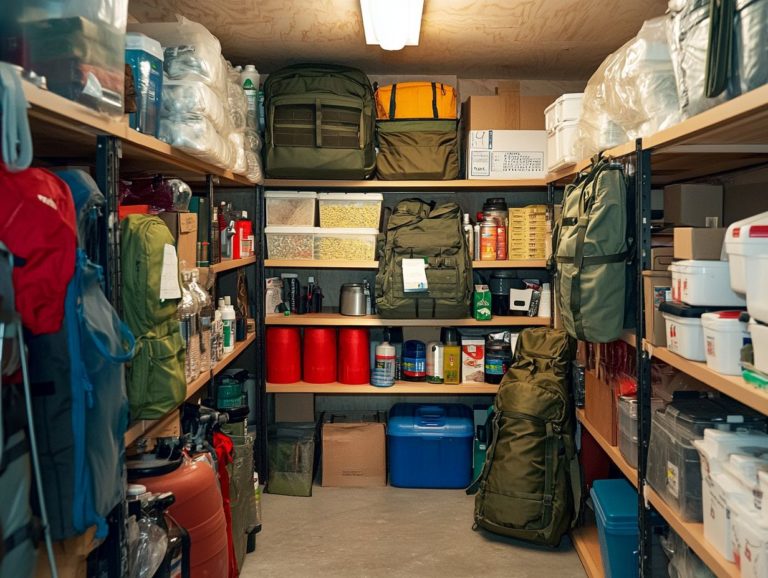Exploring the History of Survival Gear
Survival gear has significantly evolved, transforming from rudimentary primitive tools into advanced modern equipment meticulously crafted to ensure your safety in the wild. Essential items like survival kits and navigation tools, such as maps and compasses, are now standard.
This article delves into the rich history of survival gear, tracing its early applications in hunting and shelter, its pivotal role in military operations, and its captivating representation in popular culture.
Discover why survival gear is crucial during emergencies, including the use of first-aid kits and emergency rations, bolstered by compelling real-life case studies. Join in as you uncover how these indispensable tools have shaped our collective understanding of survival.
Contents
Key Takeaways:
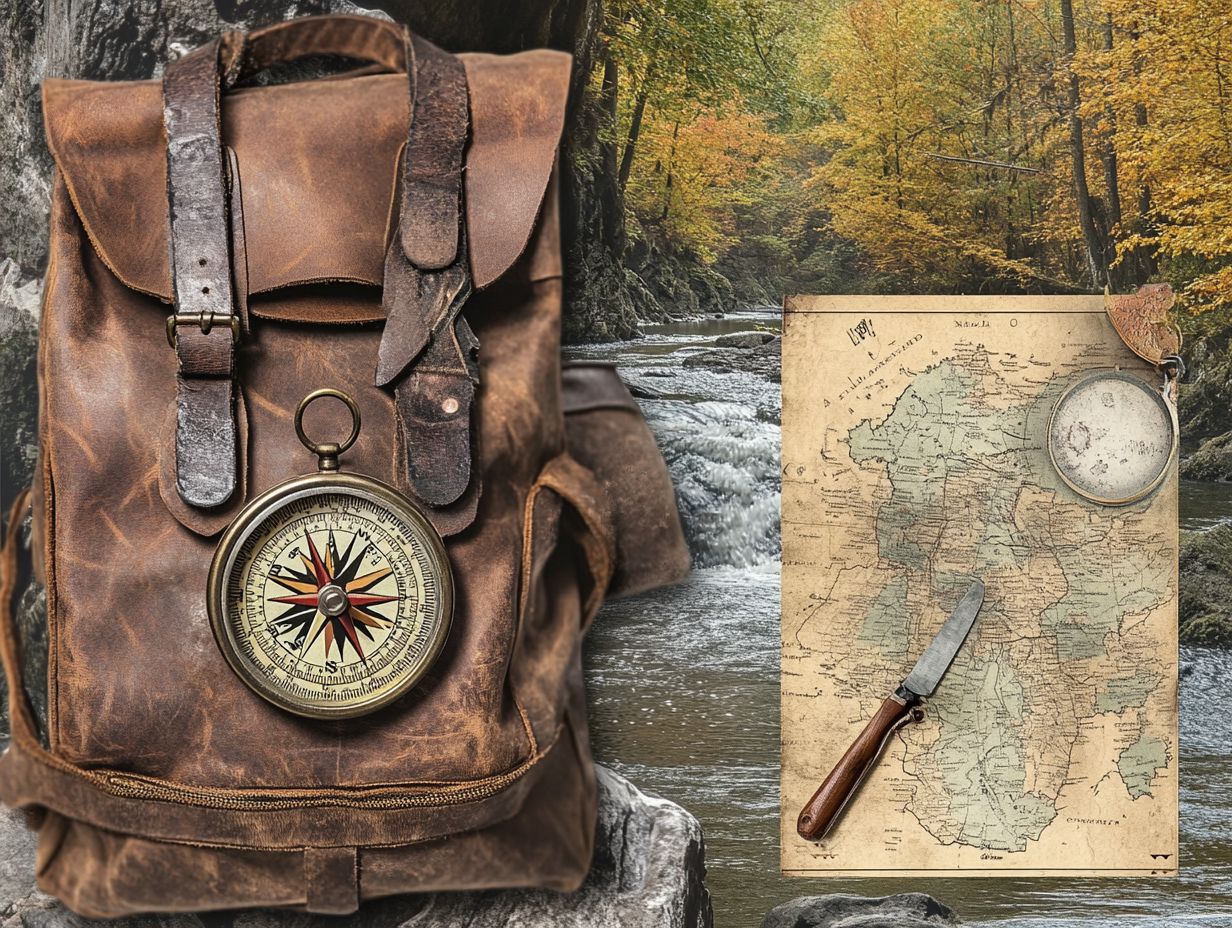
- Survival gear has come a long way, adapting to the changing needs and challenges of humanity.
- In its early days, survival gear was primarily used for hunting, shelter, and protection, essential for the well-being of early humans.
- The military has played a crucial role in the development and use of survival gear, employing it in warfare and training soldiers to survive in extreme conditions.
The Evolution of Survival Gear
The evolution of survival gear has transformed dramatically, moving from basic tools used by early humans to sophisticated modern equipment tailored for emergency situations. Contemporary survival kits now focus on essential items designed for various challenges.
Insights from military personnel, including notable figures like Sergeant Major John Lofty Wiseman and Andy McNab, have significantly influenced this evolution. Their survival knowledge, drawn from experiences in the Gulf War and other daring expeditions, underscores the importance of testing your survival gear and has shaped the way gear is developed.
This progression underscores the necessity for advanced technology and better performance in hostile environments, making survival gear more effective than ever before.
From Primitive Tools to Modern Equipment
Survival gear has evolved significantly from the primitive tools of makeshift spears and flint. Today, it includes critical navigation tools like maps and compasses essential companions for any outdoor adventure.
These early implements were vital for our ancestors, allowing them to hunt, gather, and protect themselves in harsh environments. The journey from basic hand axes to sophisticated multi-tools is a testament to human ingenuity and innovation, much like the survival gear for young explorers available today.
Today’s survival gear is designed for versatility. It ensures ease of use in emergencies, often incorporating lightweight tools and fire starters to enhance your preparedness. Advanced technology plays a crucial role here, enhancing both safety and efficiency. With features like GPS tracking, waterproof materials, and built-in communication systems, you can navigate even the most unpredictable landscapes with confidence. Understanding the importance of survival gear is essential for any outdoor enthusiast.
Early Uses of Survival Gear
Early uses of survival gear played a vital role in hunting, building shelter, and ensuring protection. By utilizing materials such as cordage, fishing line, and makeshift splints, you improve your survival efforts in nature’s unforgiving environments.
Ready to gear up? Explore our latest survival kits today!
Hunting, Shelter, and Protection
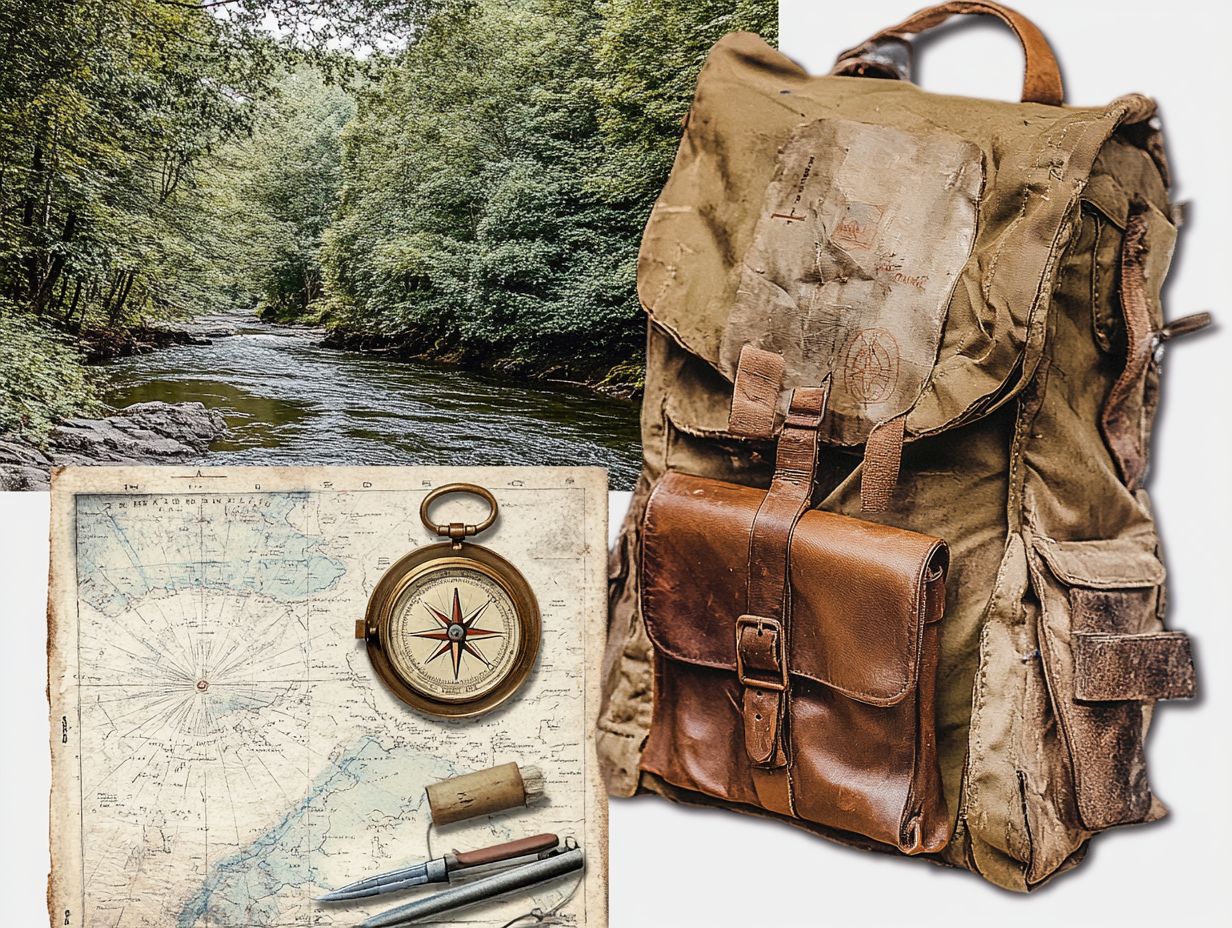
Early humans relied on hunting, shelter, and protection for survival. They depended on their survival kits to secure food, create safe living environments, and fend off potential threats.
These early hunters utilized various techniques and tools. They crafted traps to ensnare prey and spears from readily available materials. They also used methods like signal mirrors for emergencies, showing their cleverness and understanding of the environment.
Each successful hunt provided sustenance and reinforced the crucial link between food sources and sturdy shelters that could withstand the elements and deter predators.
Today, survival gear is more advanced than ever. Tools like signal mirrors improve visibility for search and rescue operations, while first-aid kits ensure essential medical assistance is available during emergencies. To ensure you’re well-equipped, consider the top features to look for in survival gear. Survival strategies are evolving to meet new challenges every day, adapting to both nature and human circumstances, including modern technology for improved emergency communications.
Survival Gear in the Military
Survival gear is essential in the military, especially for Special Forces, where survival in combat and the use of an escape kit can mean the difference between life and death. In high-stakes situations, every piece of equipment plays a critical role in emergencies.
Role in Warfare and Training
The role of survival gear in warfare goes beyond having the right equipment; it requires rigorous training that immerses you in survival knowledge. This includes mastering tools like flint and strikers for creating fire and managing emergency rations effectively.
This training equips you with practical skills essential for high-pressure situations, whether you’re navigating hostile environments or trying to survive behind enemy lines. You’ll learn how to identify safe water sources and purify water using portable filters skills that could be the difference between life and death.
Being aware of your surroundings is crucial. Recognizing signs of changing weather or potential ambush points can greatly enhance your chances of survival. Various gear, such as multi-tools for constructing shelters and signal mirrors for distress signaling, is evaluated for effectiveness in different scenarios. Understanding the future of survival gear technology ensures you are not just familiar with your equipment but capable of adapting it to meet evolving challenges in the field.
Survival Gear in Popular Culture
Survival gear is a popular theme in movies and shows. It is frequently showcased in media and entertainment as critical tools for navigating adversity, often highlighting knives and flashlights in challenging situations.
These stories inspire us with themes of resilience and creativity in the face of difficult environments, fostering creative thinking about survival strategies.
Depictions in Media and Entertainment
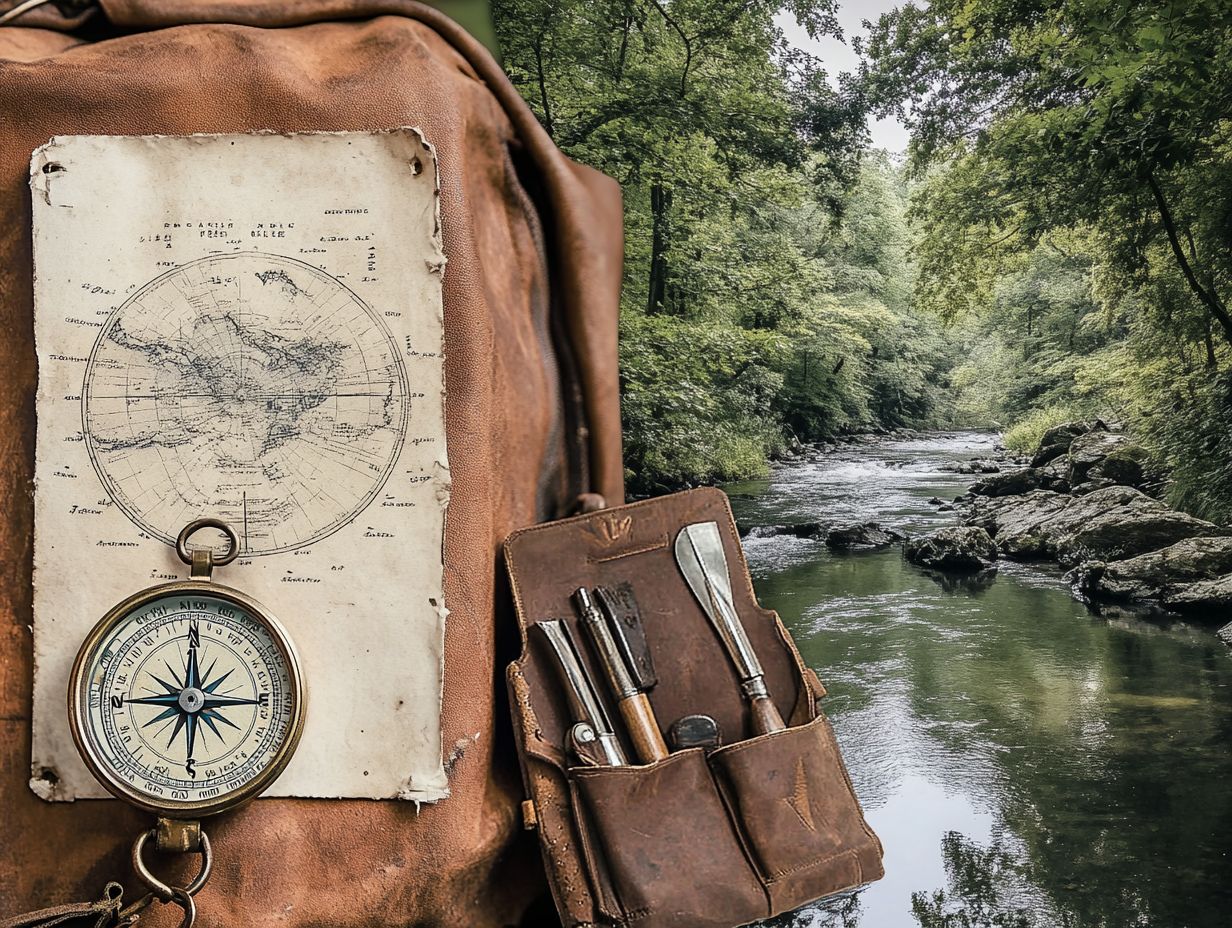
Media portrayals of survival gear spark our imagination, highlighting survival skills and the creative use of equipment to tackle emergencies. Characters navigate the perils of hostile environments, showcasing the importance of being prepared.
Films like “Cast Away” and reality shows such as “Survivor” emphasize how essential tools like knives and solar blankets can be lifesavers for sustenance and warmth. These portrayals are thrilling and highlight the importance of extreme survival gear when the stakes are high.
Consider the versatile multi-tool, for instance. Its versatility in various survival narratives, alongside key items like a flashlight, encourages reflection on what would be critical in your own emergency kit.
By presenting realistic challenges and solutions, these stories provide invaluable insights into practical survival strategies.
The Importance of Survival Gear in Emergency Situations
The significance of survival gear in emergency situations truly cannot be overstated, especially when it includes essential items like first-aid kits and tools for fire starting. It provides you with essential tools and medical supplies, giving individuals the power to navigate crises effectively.
With the right gear at your disposal, you can maintain not only your physical well-being but also your mental resilience in the face of adversity.
Examples and Case Studies
Numerous examples and case studies vividly illustrate the effectiveness of survival gear in emergency situations. Tools like water purification systems, flashlights, and emergency rations can profoundly influence outcomes.
Consider a notable incident where a group of hikers found themselves lost in the wilderness. They relied on their survival kits and signaling methods to attract attention. Understanding different types of survival gear and using portable water filters ensured they stayed hydrated and protected them from potential illness stemming from contaminated sources.
Meanwhile, using compact, high-lumen flashlights allowed them to navigate challenging terrain after dark, enabling them to signal for help effectively using their survival knowledge.
Some gear can have issues. In another scenario, a malfunctioning GPS device led to increased disorientation, underlining the importance of having backup tools in place.
Real-life experiences have led to innovations in gear design, compelling manufacturers to prioritize reliability and enhance user-friendliness, integrating modern technology and lightweight tools for better performance.
Frequently Asked Questions
What is survival gear?
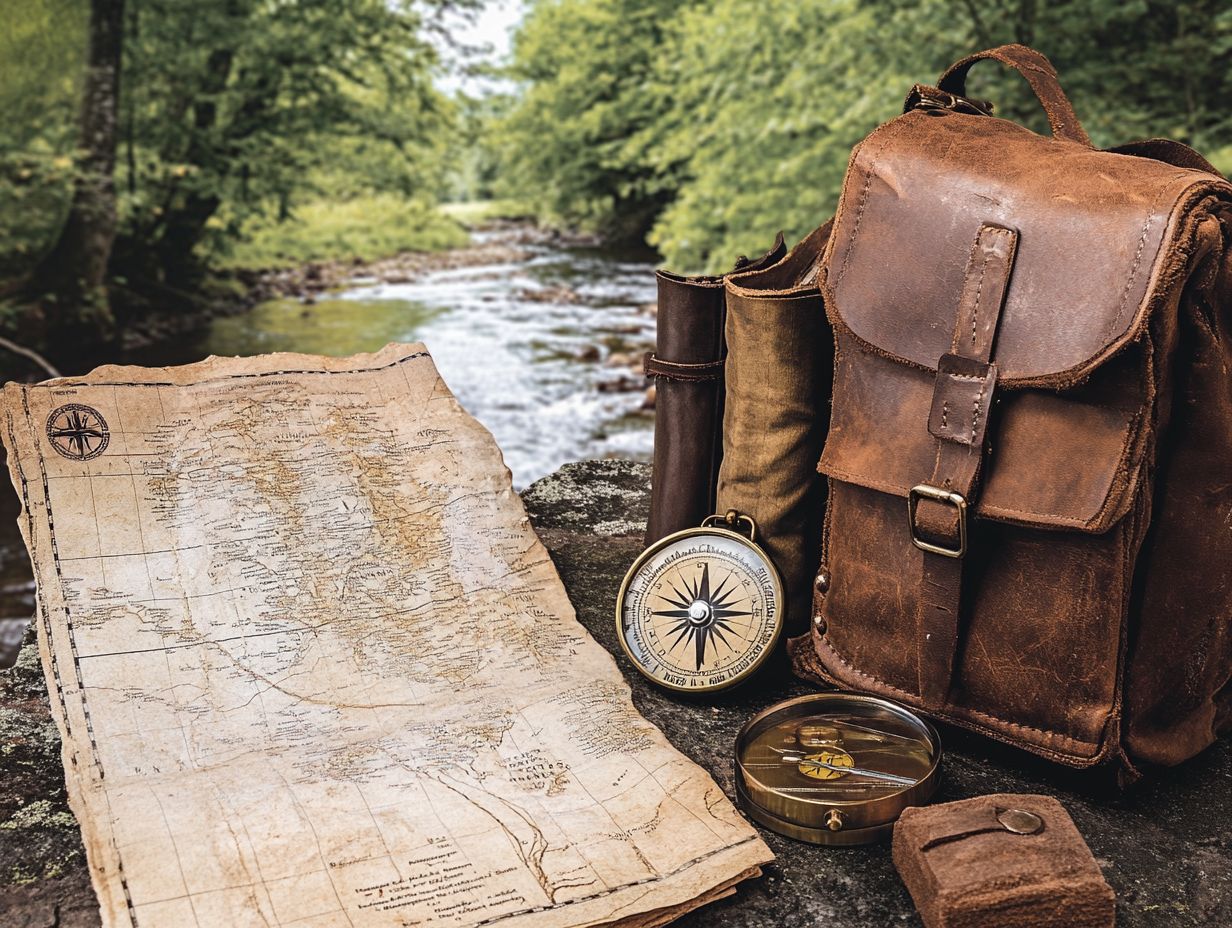
Survival gear is crucial for staying safe during emergencies. It refers to any equipment or supplies that aid in surviving in emergency or disaster situations. Essential items include first aid kits, water filters, and tools for shelter building and fire starting.
When did the use of survival gear begin?
The use of survival gear can be traced back to early human civilizations, where tools for hunting, shelter building, and fire starting were essential for survival. However, the term “survival gear” became more commonly used during the early 20th century.
How has survival gear evolved over time?
In the past, survival gear mainly focused on tools and supplies for hunting and shelter building, including essential items such as a knife for cutting and preparing food. However, as technology advanced, the range of survival gear expanded to include items such as GPS devices, high-tech first aid kits, portable water filters, and adventure essentials like a map, compass, and fire starter.
What significant events have influenced the development of survival gear?
The two World Wars and the Cold War significantly impacted the development of survival gear. These events highlighted the need for individuals and organizations to be prepared for emergencies and disasters, leading to the creation of more specialized and advanced survival gear.
Who uses survival gear?
Survival gear is used by a wide range of individuals and organizations, including outdoor enthusiasts, military personnel such as the Special Forces, and emergency responders. It can also be found in homes and workplaces as part of emergency readiness plans, including water containers and a survival handbook for guidance.
What should I consider when choosing survival gear?
When selecting survival gear, it is essential to consider factors such as the intended use, quality and durability, and the specific needs of the individual or situation, especially when planning a backpacking trip or engaging in backcountry exploration. Regularly checking and maintaining the gear ensures it is always ready for use in an emergency, which can include items like paracord, fishing line, and alcohol swabs.

